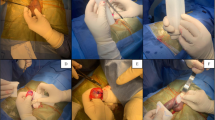Abstract
Penile fibrosis (PF) may be a complication of intracavernosal injection therapy (ICI). It has been well documented as a side effect of papaverine, but there have been few reports associating penile fibrosis with prostaglandin E1 (PGE1, Alprostadil). Many authors did not find fibrotic changes in the penis while others reported penile fibrosis as a complication of intracavernosal PGE1 in only 0.76–2.1% of their patients. Recent studies, however, suggest that the incidence may be as high as 15%.
Three hundred consecutive patients who returned to our Institute for repeat prescription of PGE1 were asked about penile curvature and deformity and the penis was examined for fibrotic change. Twenty-two were excluded because of concurrent or previous use of papaverine and/or phentolamine, 30 patients had pre-ICI evidence of fibrotic change and 3 had incomplete data. Of the remaining 245 patients, 57 (23.3%) were found to have penile fibrosis. These men, mean age 62 y (21–79), had been self injecting an average of 5.2 times per month (1–16) for an average period of 29.2 months (2–86). The mean dose of PGE1 used was 13 µg (2–60) and an average of 65.6 µg of PGE1 (3–360) was used per month. The mean total number of injections was 142.4 (8–810) and the mean total amount of PGE1 1703 µg (105–11520).
Penile fibrosis is hence a significant complication of intracavernosal PGE1 therapy. It is mandatory to examine patients methodically for fibrotic changes in the penis prior to commencement of treatment and at subsequent regular reviews. Patients should be specifically warned of the possibility of penile fibrosis and should be instructed on self examination so that they may report early changes if and when these occur.
This is a preview of subscription content, access via your institution
Access options
Subscribe to this journal
Receive 8 print issues and online access
$259.00 per year
only $32.38 per issue
Buy this article
- Purchase on Springer Link
- Instant access to full article PDF
Prices may be subject to local taxes which are calculated during checkout
Similar content being viewed by others
Author information
Authors and Affiliations
Rights and permissions
About this article
Cite this article
Chew, KK., Stuckey, B., Earle, C. et al. Penile fibrosis in intracavernosal prostaglandin E1 injection therapy for erectile dysfunction. Int J Impot Res 9, 225–229 (1997). https://doi.org/10.1038/sj.ijir.3900296
Received:
Accepted:
Issue Date:
DOI: https://doi.org/10.1038/sj.ijir.3900296
Keywords
This article is cited by
-
Surgical tips in difficult penile prosthetic surgery: a narrative review
International Journal of Impotence Research (2023)
-
Are finasteride-related penile curvature/Peyronie’s disease Adverse Event Reports worthy of further clinical investigation? Disproportionality analysis based on both the Food and Drug Administration (FDA) and the European Medicines Agency (EMA) pharmacovigilance databases
International Journal of Impotence Research (2023)
-
Combination therapy for erectile dysfunction involving a PDE5 inhibitor and alprostadil
International Journal of Impotence Research (2018)
-
The prevalence of Peyronie's disease in diabetic patients with erectile dysfunction
International Journal of Impotence Research (2007)
-
Intracavernosal prostaglandin E1 self vs office injection therapy in patients with erectile dysfunction
International Journal of Impotence Research (2006)



